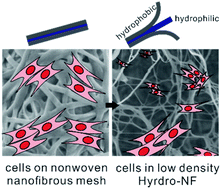Our official English website, www.x-mol.net, welcomes your
feedback! (Note: you will need to create a separate account there.)
Hydro-nanofibrous mesh deep cell penetration: a strategy based on peeling of electrospun coaxial nanofibers†
Nanoscale ( IF 5.8 ) Pub Date : 2018-02-26 00:00:00 , DOI: 10.1039/c7nr04928e Y. J. Son 1, 2, 3, 4 , H. S. Kim 5, 6, 7, 8 , W. Mao 1, 2, 3, 4 , J. B. Park 4, 9, 10, 11 , D. Lee 4, 12, 13, 14 , H. Lee 4, 12, 14, 15, 16 , H. S. Yoo 1, 2, 3, 4, 17
Nanoscale ( IF 5.8 ) Pub Date : 2018-02-26 00:00:00 , DOI: 10.1039/c7nr04928e Y. J. Son 1, 2, 3, 4 , H. S. Kim 5, 6, 7, 8 , W. Mao 1, 2, 3, 4 , J. B. Park 4, 9, 10, 11 , D. Lee 4, 12, 13, 14 , H. Lee 4, 12, 14, 15, 16 , H. S. Yoo 1, 2, 3, 4, 17
Affiliation

|
A two-step strategy for coaxial electrospinning and postelectrospinning is an effective method for fabricating superfine nanofibers composed of highly swellable hydrogels. Alginate and poly(ε-caprolactone) [PCL] were coelectrospun via fibrous meshes with a coaxial nozzle; alginate at the core was subsequently cross-linked in calcium chloride solution. The PCL sheath was removed from the meshes by repeated organic-phase washing. The peeling process was monitored by scanning electron microscopy, transmission electron microscopy, and differential scanning calorimetry, and the complete removal of the PCL outer layers was confirmed by the thinning of the fiber volume. The obtained alginate hydronanofiber showed extreme water-swellability and mass erosion depending on the degree of cross-linking. We also measured the nanoscale and macroscale mechanical properties of a single nanofiber and of the whole mesh by atomic force microscopy and rheometry. Quantitative analysis of nanomechanical properties indicated that the hydronanofiber with higher cross-linking density had higher stiffness and Derjaguin–Müller–Toporov modulus. Cells laid on the mesh and the vertical infiltration distance were visualized and quantified by confocal laser scanning microscopy. Cells on the mesh with higher cross-linking density infiltrated deeply to the bottom of the mesh. Thus, hydrogel-like nanofibrous meshes are versatile matrices allowing for deep infiltration of cells throughout the mesh via manipulation of the mechanical properties of the nanofiber.
中文翻译:

水-纳米纤维网深层渗透:基于静电纺同轴纳米纤维剥离的策略†
同轴电纺和后电纺的两步策略是一种有效的方法来制造由高度可溶胀的水凝胶组成的超细纳米纤维。海藻酸盐和聚(ε-己内酯)[PCL]通过带有同轴喷嘴的纤维网;随后将核心处的海藻酸盐在氯化钙溶液中交联。通过重复的有机相洗涤将PCL鞘从网状物上除去。通过扫描电子显微镜,透射电子显微镜和差示扫描量热法监测剥离过程,并且通过纤维体积的减薄证实了PCL外层的完全去除。所获得的藻酸盐氢纳米纤维根据交联程度显示出极高的水溶胀性和质量侵蚀。我们还通过原子力显微镜和流变仪测量了单个纳米纤维和整个网的纳米级和宏观力学性能。纳米力学性能的定量分析表明,具有较高交联密度的氢纳米纤维具有较高的刚度和德雅金-米勒-托普洛夫模量。通过共聚焦激光扫描显微镜观察和定量放置在网孔上的细胞和垂直渗透距离。具有较高交联密度的网格上的单元格深深地渗透到网格的底部。因此,类似水凝胶的纳米纤维网是通用的基质,可以使整个网格中的细胞深度浸润通过控制纳米纤维的机械性能。
更新日期:2018-02-26
中文翻译:

水-纳米纤维网深层渗透:基于静电纺同轴纳米纤维剥离的策略†
同轴电纺和后电纺的两步策略是一种有效的方法来制造由高度可溶胀的水凝胶组成的超细纳米纤维。海藻酸盐和聚(ε-己内酯)[PCL]通过带有同轴喷嘴的纤维网;随后将核心处的海藻酸盐在氯化钙溶液中交联。通过重复的有机相洗涤将PCL鞘从网状物上除去。通过扫描电子显微镜,透射电子显微镜和差示扫描量热法监测剥离过程,并且通过纤维体积的减薄证实了PCL外层的完全去除。所获得的藻酸盐氢纳米纤维根据交联程度显示出极高的水溶胀性和质量侵蚀。我们还通过原子力显微镜和流变仪测量了单个纳米纤维和整个网的纳米级和宏观力学性能。纳米力学性能的定量分析表明,具有较高交联密度的氢纳米纤维具有较高的刚度和德雅金-米勒-托普洛夫模量。通过共聚焦激光扫描显微镜观察和定量放置在网孔上的细胞和垂直渗透距离。具有较高交联密度的网格上的单元格深深地渗透到网格的底部。因此,类似水凝胶的纳米纤维网是通用的基质,可以使整个网格中的细胞深度浸润通过控制纳米纤维的机械性能。











































 京公网安备 11010802027423号
京公网安备 11010802027423号